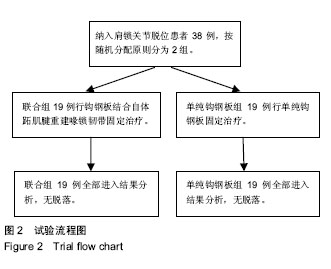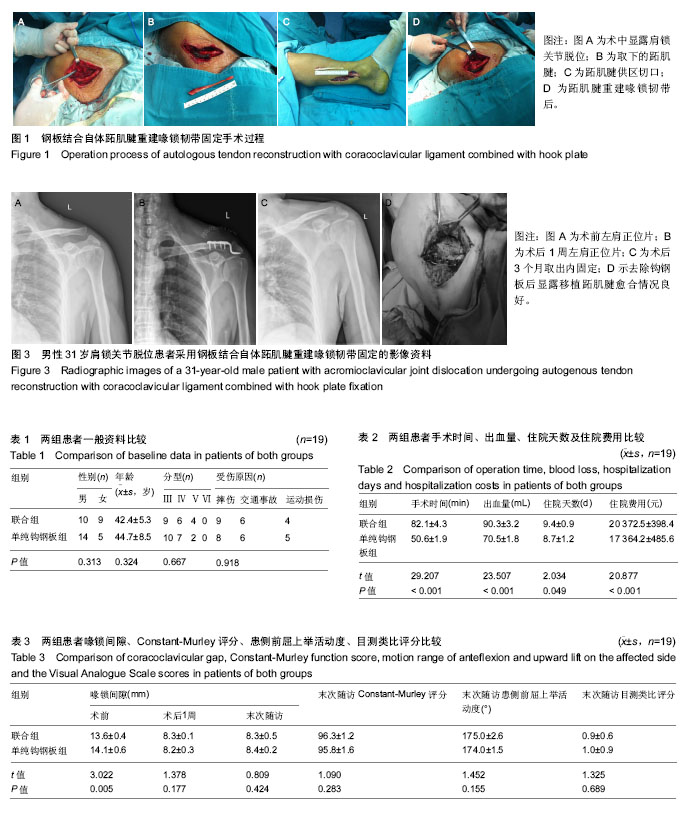| [1] Warth RJ, Martetschlager F, Gaskill TR, et al. Acromioclavicular joint separations.Curr Rev Musculoskelet Med.2013;6(1):71-78.[2] Ha AS,Petscavage-Thomas JM, Tagoylo GH. Acromioclavicular joint in the shoulder.AJR Am J Roentgenol. 2014;202(2):375-385.[3] Smith TO,Chester R,Pearse EO,et al.Operative versus non-operative management following Rockwood grade Ⅲ acromioclavicular separation:a meta -analysis of the current evidence base .J Orthop Traumatol.2011;12(1):19-27.[4] 姜晨轶,张长青.锁骨钩钢板治疗肩锁关节脱位及锁骨远端骨折后并发症的研究进展[J].中华创伤骨科杂志, 2013,15(10): 898-901.[5] 吴天龙,涂以济,陈伟才,等.锁骨钩钢板治疗急性肩锁关节脱位喙锁韧带重建与否的疗效比较[J].中国矫形外科杂志,2013, 21(16):1597-1600.[6] 印飞.跖肌腱移植重建喙锁及肩锁韧带结合钢板固定治疗肩锁关节脱位[J].中国修复重建外科杂志,2015,29(5): 652-654.[7] Li X, Ma R, Bedi A, et al. Management of acromioclavicular joint injuries. J Bone Joint Surg Am. 2014;96(1):73-84.[8] 叶晖,林其仁,王文怀,等.同种异体肌腱结合锚钉重建喙锁韧带治疗急性肩锁关节脱位[J].中华手外科杂志,2014,30(4):265-267.[9] Flinkkila T, Ristiniemi J. Surgical treatment of unstable fractures of the distal clavicle: a comparative study of Kirschner Wire and clavicular hook plate fixation. Acta Orthopaedica Scandinavica. 2002;73(1):50-53.[10] 刘惠勇,田军.锁骨钩钢板治疗肩锁关节脱位和锁骨远端骨折的疗效分析[J].中国医师进修杂志,2013,26(2):55-56.[11] Wojtys EM, Nelson G. Conservative treatment of grade III acromioclavicular dislocations.Clin Orthop.1991;268:112-119.[12] Cote MP, Wojcik KE, Gomlinski G, et al. Rehabilitation of acromioclavicular joint separations: operative and nonoperative considerations. Clin Sports Med. 2010;29(2): 213-228.[13] 扶世杰,关钛元,杨本伍,等.关节镜下自体肌腱重建与锁骨钩钢板治疗Rockwood Ⅲ型肩锁关节脱位的疗效比较[J].中华创伤骨科杂志,2013,15(10):912-914.[14] 安维军,孙建斌,叶鹏.等.喙锁韧带重建联合钩钢板固定或缝合锚固定治疗肩锁关节脱位的对比研究[J].中华外科杂志, 2013, 51(4):349-353.[15] 冯健,胡祖愉,刘洪新,等.微创喙锁韧带重建术治疗RockwoodIII型急性肩锁关节脱位[J].临床骨科杂志,2010,13(6):672-674.[16] Nüchtern JV, Sellenschloh K, Bishop N, et al. Biomechanical evaluation of 3 stabilization methods on acromioclavicular joint dislocations.Am J Sports Med. 2013;41(6):1387-1394.[17] Faraj AA, Ketzer B. The use of a hook-plate in the management of acromioclavicular injuries.Report of ten cases. Acta Orthop Belg. 2001;67(5):448-451.[18] 王古衡,谢仁国,汤锦波,等.同种异体肌腱重建喙锁和肩锁韧带治疗肩锁关节脱位[J].中华手外科杂志,2013,29(3):150-153.[19] 马双陶,陈卫军,王文生,等.跖肌腱移植的应用解剖[J].中国临床解剖学杂志,2007,25(3):262-265.[20] 马双陶,陈卫军.人跖肌腱的力学性质测试与组织学观察[J].第三军医大学学报,2007,29(19):1889-1891.[21] 张春礼,范宏斌,吕荣,等.自体和异体肌腱移植重建前十字韧带后止点转归的组织学研究[J].中华骨科杂志,2004,3(24):146-149.[22] 夏春,周江南,付日斌,等.自体Hamstring腱重建前交叉韧带术后关节镜下再视观察[J].中国微创外科杂志, 2005,5(12): 1006-1008.[23] Bin Abd Razak HR, Yeo EN, et al. Short-term outcomes of arthroscopic TightRope® fixation are better than hook plate fixation in acute unstable acromioclavicular joint dislocations. Eur J Orthop Surg Traumatol. 2017doi:10.1007/s00590-017-2095-5.[24] Xu D, Luo P, Chen J, et al. Outcomes of surgery for acromioclavicular joint dislocation using different angled hook plates: a prospective study. Int Orthop. 2017;41(12): 2605-2611.[25] Mah JM; Canadian Orthopaedic Trauma Society (COTS). General Health Status After Nonoperative Versus Operative Treatment for Acute, Complete Acromioclavicular Joint Dislocation. Results of a Multicenter Randomized Clinical Trial. J Orthop Trauma. 2017;31(9):485-490.[26] Domos P, Sim F, Dunne M, et al. Current practice in the management of Rockwood type III acromioclavicular joint dislocations-National survey. J Orthop Surg (Hong Kong). 2017;25(2):2309499017717868. [27] Cai L, Wang T, Lu D, et al. Comparison of the tight rope technique and clavicular hook plate for the treatment of Rockwood type III acromioclavicular joint dDislocation. J Invest Surg. 2017:1-8. [28] Arirachakaran A, Boonard M, Piyapittayanun P, et al. Post-operative outcomes and complications of suspensory loop fixation device versus hook plate in acute unstable acromioclavicular joint dislocation: a systematic review and meta-analysis. J Orthop Traumatol. 2017;18(4):293-304.[29] Hung LK, Su KC, Lu WH, et al. Biomechanical analysis of clavicle hook plate implantation with different hook angles in the acromioclavicular joint. Int Orthop. 2017;41(8):1663-1669. [30] Natera Cisneros LG, Sarasquete Reiriz J. Acute high-grade acromioclavicular joint injuries: quality of life comparison between patients managed operatively with a hook plate versus patients managed non-operatively. Eur J Orthop Surg Traumatol. 2017;27(3):341-350.[31] Cox CL. Hook-plate fixation in patients with acute acromioclavicular joint dislocation improved radiographic but not clinical outcomes compared with nonoperative treatment. J Bone Joint Surg Am. 2016;98(16):1405. [32] Godry H, Citak M, Königshausen M, et al. Treatment of chronic acromioclavicular joint dislocation in a paraplegic patient with the weaver-dunn procedure and a hook-plate. Orthop Rev (Pavia). 2016;8(2):6371. [33] Arirachakaran A, Boonard M, Piyapittayanun P, et al. Comparison of surgical outcomes between fixation with hook plate and loop suspensory fixation for acute unstable acromioclavicular joint dislocation: a systematic review and meta-analysis. Eur J Orthop Surg Traumatol. 2016;26(6): 565-574. |
.jpg)


.jpg)